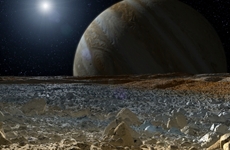NASA to look for life in Jupitor’s moon Europa
08 Aug 2013
The National Aeronautics and Space Administration (NASA) is embarking on a new mission to find whether planet Jupiter's moon Europa could support life or has already life forms inhabiting it.
 With hints gleaned from a dozen or so close flybys from NASA spacecraft - Voyager 2 in 1979 and Galileo in the mid-to-late 1990s - of a salty ocean lying beneath a layer of fractured ice, Jupiter's moon Europa is now on NASA's list of suitable homes for ETs in the solar system.
With hints gleaned from a dozen or so close flybys from NASA spacecraft - Voyager 2 in 1979 and Galileo in the mid-to-late 1990s - of a salty ocean lying beneath a layer of fractured ice, Jupiter's moon Europa is now on NASA's list of suitable homes for ETs in the solar system.
In these fleeting encounters, scientists have seen a fractured, ice-covered world with signs of a liquid water ocean under its surface, NASA said, adding that such an environment could potentially be a hospitable home for microbial life.
''So if we landed a spacecraft on Europa, what would it look for and what tools would it carry?''
Now NASA has begun mapping out what a future mission to this intriguing worldlet may look like.
A new paper by leading planetary researchers released this week in the journal Astrobiology details plans for a possible lander being launched sometime in the next decade. The vehicle would boast a drill and microscope camera, similar to instruments aboard Mars Curiosity and Cassini.
''Europa is the most likely place in our solar system beyond Earth to have life today, and a landed mission would be the best way to search for signs of life,'' said Robert Pappalardo, the lead author of the study, and researcher at NASA's Jet Propulsion Laboratory in a press statement.
Europa is believed to have a hidden ocean formed by tidal forces from nearby Jupiter's massive gravitational effect that heats the moon's interior. Researchers have identified dark, red-tainted fractures scattered across the moon's icy shell that suggest that dirty, briny water has welled up and frozen on the moon's surface as potential spots to search for possible microbial life.
Scientists will study the reddish ''freckles'' and cracks that stain the icy surface and their chemistry to know whether these are among the building blocks of life.
''Landing on the surface of Europa would be a key step in the astrobiological investigation of that world,'' said Chris McKay, a senior editor of the journal Astrobiology who is based at NASA Ames Research Center in California.
''This paper outlines the science that could be done on such a lander,'' said McKay. ''The hope would be that surface materials, possibly near the linear crack features, include biomarkers carried up from the ocean.''
NASA's Juno probe - which will go into orbit around the Jupiter system in 2016 - will probably be tasked in helping to pin down potential landing sites for a Europa lander, thanks to its high resolution cameras.






























